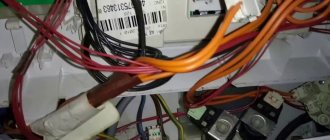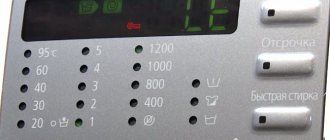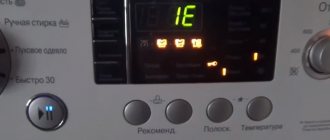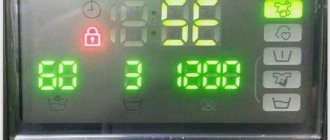The failure of household appliances almost always entails significant financial costs. Especially when it comes to large equipment - a refrigerator, electric oven or washing machine. Calling a technician just to determine the breakdown and identify its causes is usually paid for. And then there is a call for a cargo taxi, delivery of household appliances to the workshop, etc. In this article I will describe the most common washing machine malfunctions, their probable causes, as well as how to fix them yourself.
Regardless of the manufacturer and model, all typical washing machine breakdowns can be summarized in the following list:
- Does not drain water during operation or spinning;
- Does not turn on - the control panel does not light up;
- Does not heat water;
- Leaks;
- During the spin cycle, the program freezes or the function does not work;
- The loading hatch does not open.
Let's look at the listed washing machine malfunctions, their causes and elimination in more detail.
Washing machine won't turn on
Let's look at the problem: the machine won't turn on.
It may not respond to being plugged in at all. The indicators may light up, but the machine does not go into operating mode, the buttons are not active.
Eating problems
The first thing to do is check if the outlet is working. To do this, you can include any known working device in it. Next you should inspect the fork. It may be damaged or broken at the junction with the cord. And it happens that the plug is simply not tightly inserted into the connector. If the machine is connected through a surge protector, you can check it too. If you've looked through everything and haven't found the problem, move on to the next step.
Incorrect inclusion
Perhaps everything is fine with your assistant, but the order in which it was turned on is incorrect. Many machine models have a “child lock” option; it is needed to prevent accidental activation. When you turn on this program, the buttons do not work. Usually, this is some combination of 2-3 buttons that is triggered when pressed simultaneously for a certain time. The indicator of this function or the indicators of the buttons pressed will light up on the front panel (depending on the brand and model of the machine).
Many machines will not turn on if the door lock is not latched. In this case, the indication will light up as usual, but the wash will not start. Perhaps laundry just got caught in the lock. Inspect the lock hook, it may be deformed and this is precisely the problem.
Problems with the control module
If it is not clear why the washing machine does not work (there are no apparent reasons), then with a high degree of probability the control module has failed. The first thing that can be assessed visually is the condition of the board. For example, in top-loading Ardo machines, sometimes a module pops out of its seat. Vibrations can cause this to happen to any other model. Also check to see if the circuit is flooded with water. Externally, you can evaluate the FPS - the network capacitor; it burns most often. Then you can “ring” the remaining elements for operability: input resistors, diode bridge and others. For Samsung machines older than 7-8 years, the sore spot is the step-down transformer.
Signs of breakdown
You can start looking for the answer to the question: “How to fix a washing machine with your own hands?” when:
- The car does not respond to the start button. If there is light in the house, most likely there is something wrong with the power supply to the device itself.
- The machine responds to the power button, but it is impossible to set a program or individual function. Again, the first thing to do is diagnose the power supply.
- The machine turns on, I can select a program, but during the wash there is a strange sound - a knocking sound or something else. In such cases, you have to repair the washing machine drum.
- Water does not drain. Then the problem is in the pump.
This is a non-exhaustive list of signs. There may be others that indicate equipment failure. But don’t get upset right away and don’t rush to call the service, as you can handle some problems yourself.
The drum does not spin
The drum may simply mechanically jam. This can be checked by moving it from the inside. A jammed drum will remain in place, or will play a little, but not rotate. After removing the housing, look to see if any small objects are stuck between the tank and the drum. In narrow Indesit machines, buttons and “bones” from linen very often fall under the elastic into this space. A bearing that has failed due to wear can also jam the drum. To replace it, you will need to disassemble the tank. The destruction of the bearings is determined visually; replacement will require some effort.
If, after starting the program, you can hear the engine running, but the drum does not spin, it means the transmission belt has come off. If the design provides, then it can be tightened. If this is not possible, as well as in cases where the belt breaks, it must be replaced with a new one. When purchasing this part, it is important to choose one that is identical in geometry (length, number of wedges).
In direct drive machines (mostly represented on the Russian market by the LG brand), the drum is connected directly to the engine. In this case there is no transmission link, the reliability of the design is higher. But if a problem does occur, it is a global one - leaks from the drum go directly into the engine (through the shaft seal), causing a short circuit. In this case, repairs will have to be done by a service center and at great expense.
If the drum in the belt machine does not spin and the sound of the motor is not heard, the motor brushes most likely need to be replaced. You will need to disassemble the engine, remove the burnt brushes, and install new ones in their place.
It is imperative to clean the collector lamellas to ensure good contact. The cause of the breakdown may be a broken motor power cable. Most likely this can happen in places where it is bent. Much less often there are gaps between the control module and the engine itself, when the command to start work simply does not reach the performer.
Repair
Repairing washing machine faults requires skills in working with tools and at least minimal knowledge of electronic equipment. The approximate work plan presented below will allow you to avoid annoying mistakes and eliminate problems yourself.
Washing machine pumps
Even professionals rarely attempt to repair a broken drain pump. This device is not too expensive and is easier to replace entirely. The main thing is to find a part of a suitable brand in the store.
The pump is replaced as follows.
- Remove the bottom panel.
- Using a screwdriver, disconnect the pump from the machine body.
- By pressing on the drain valve from the outside, push the pump inside the housing and pull it out.
- Disconnect all wires leading to the pump.
- Remove the drain hose and pipe.
- Installing a new device.
After this, you need to reassemble the washing machine, performing all the steps in reverse order, put it in the working position and check the operation of the new part by turning on the wash without laundry.
Washing machine control module
In many models, the control board is located at the top of the front of the machine; removing it is not difficult. Having freed the substrate with the microcircuit from the fixing strips, you need to carefully examine it. Signs that repairs are needed include:
- the plate has changed color in some places, the tracks have darkened;
- torn capacitor caps;
- The place where the main processor is installed has darkened.
If you discover one of these defects, it is better to immediately contact the workshop. After all, to repair a microcircuit you will need both the appropriate skills and the ability to work with a soldering iron.
Bearing replacement
If the washing machine starts spinning loudly, then one of the reasons may be damage to the bearing. To change bearings in a top-loading machine, you must:
- Disassemble the device body and remove the back wall.
- Remove the belt from the pulley, allowing access to the bearing system.
- Unscrew the central bolt securing the pulley to the drum and remove the pulley.
- Unscrew the three screws securing the structure and remove the coupling with bearings.
- Remove the O-ring and oil seal from the shaft, which will also have to be replaced.
Then all that remains is to install new parts and reassemble the washing machine, doing the work in reverse order.
Replacing the heating element
The heating element often requires replacement. It can burn out from long-term use or unstable voltage in the electrical network. From constant contact with water, the tubes of the heating device become covered with scale.
Changing the heating element is not difficult, you just need to do the following:
- Remove the back panel, since most often the heating element is located in the rear of the case.
- Disconnect the electrical appliance connection terminals.
- To remove a faulty heating element, you need to unscrew the nut using a wrench and press on the stud with a screwdriver. Use a twisting motion to remove the damaged part from the seal.
- Install the new part, trying to place the heating element evenly, without deforming the seal.
- Insert the stud into place, tighten the nut, and connect the wires.
By photographing the position of the parts and wires before disassembling, you can make your work much easier.
The water does not heat up during the washing process
Washing in cold water is not the most efficient process. Therefore, if the machine works: it turns on, starts modes, spins the drum, but does not heat the water, this is a reason to work on it.
Most often, with almost 100% probability, the source of this problem is the failure of the heating element (TENA). This may happen for the following reasons:
- hard water causes scale to form on the body of the TEN. On the one hand, this reduces the conductivity of heat, on the other, the destruction of the metal under the layer of salts;
- wear of the part over time (usually the manual indicates the maximum service life of the machine, taking into account the onset of natural wear);
- constant power surges in the network.
To get to this part, for example, in LG and Indesit machines, you need to remove the back wall of the unit. An elongated TEN nest will be visible below the drum. Disconnect all sensors and cables and pull the heater towards you. Sometimes it immediately becomes clear that the part is no longer working. If not, call it with a tester.
In Bosh and Siemens washing machines, the heater is located at the front. First you need to remove the top cover of the machine, dismantle the powder container and the control panel (it is not necessary to disconnect it, just lift it up). Next, you should remove the sealing rubber of the hatch (by removing the clamp from it) and tuck it inside. Unscrew the lock. By removing the lower decorative trim and unscrewing the fasteners under it, you can detach the front panel of the machine. There will be a TEN below the drum.
If the water heater itself is in order, the contacts to it are also in order, and the water during washing is still cold, then you should consider the following options:
- The temperature sensor is faulty. It is located at the end of the TEN.
- The control module does not work, there is no connection with it (broken wiring).
- The machine draws water during the washing process. This happens if the drain hose is not secured, is too low (less than 60 cm from the floor), and water from the drum spontaneously goes down the drain.
Obligations of sellers and manufacturers
Each manufacturer of household appliances provides a warranty period for the products they sell. This means the period during which the washing machine should operate without failures, provided that the operating rules are followed.
Warranty periods vary from manufacturer to manufacturer. Moreover, the differences concern not only equipment from different brands, but also individual parts and assemblies within the same brand of washing machine. For example, LG provides a 3-year warranty on its car, and the warranty period for the motor of the same household appliance is 10 years.
Warranty periods for washing machines of common brands:
- Bosch – 2 years;
- Indesit – 1 year;
- Atlant – 2 years;
- Siemens – 2 years.
The store selling the washing machine is obliged to comply with the warranty periods established by the manufacturer. Moreover, a company producing products for wide export can set its own warranty period for each importing country.
At his own discretion, the seller cannot change the period noted on the coupon. However, trying to sell a product, sellers often deceive in words: they name one term, although in reality it is different. Therefore, when making a purchase, you should definitely look at the warranty sheet. The seller is also obliged to put a stamp on the coupon, otherwise the service center will refuse to accept the equipment for free repair.
The machine door does not open
Quite often on forums the following situation is described: the machine washed, but the door did not unlock. The master was called, but he will not appear soon. You have to regularly move the laundry in a circle so that it does not fade.
This situation with the door can happen for two reasons:
- The machine does not drain the water completely, or for some reason the sensor thinks that the water has not been drained completely and does not release the door.
- The UBL unit (hatch locking device) itself broke down.
The machine does not drain water
If the machine does not drain water from the tank once or constantly after the end of the washing cycle, then the breakdown must first be looked for in the drainage system (valves, filter, pump, drain hose).
First you need to drain all the water from the machine. First, try turning it off for 5-10 minutes, then run the drain program - sometimes this is enough. If that doesn’t work, then you can use gravity: raise the machine higher, and drain the drain hose as low as possible. The water will drain by itself.
The outlet filter must be washed regularly. It gets clogged with lint from fabrics, small objects (buttons) and even socks. Over time, all this also becomes covered with slippery mud, emitting an unpleasant odor. The outlet narrows and the drainage is disrupted. The filter is located on the front of the machine at the bottom right. When unscrewing it, place the container to collect water downwards. Rinse the part and put it back. Check the drain hose for obstruction. It happens that the drain filter does not unscrew due to foreign objects or scale. Then you will have to remove the front panel of the machine and get to the filter from the inside.
If after these manipulations your assistant does not work as it should, then there is a breakdown in the pump or in that part of the control module that is responsible for the pump. In principle, you can change the pump yourself, but you will need some skill and experience.
The door lock is broken
If the lock is jammed, you can try to open it with a fishing line. Insert it at the bottom of the hatch and try to lift the lock hook upward. If this does not work, you will have to remove the lock manually. After removing the top cover of the machine, reach the hook on the inside and open the lock. If the hook is worn out or deformed, it must be replaced, otherwise the problems may recur.
Troubleshooting
Modern automatic washing machines are equipped with an electronic display and a self-diagnosis system that monitors the operation of the device and, in the event of a malfunction, displays the corresponding error code.
If during washing the program is interrupted and an error code is displayed on the screen, just open the instructions and see what exactly it means. Some of the error codes are not directly accessible to the user, but are displayed when performing a service test.
An alternative to error codes is a combination of flashing lights. This warning system is found in washing machines with analog control and without a display. The operating instructions contain descriptions of the main signals that allow the user to find out the cause of the breakdown. In some cases, errors can be eliminated yourself, and in some cases you cannot do without a service specialist.
If the washing machine is equipped with a mechanical control, you will have to look for the fault yourself, based on the characteristic symptoms. So, if the laundry is dirty after washing, it is possible that the SMA does not pick up the powder or does not heat the water. There may be no breakdown at all, and the reason for the poor quality of washing is due to an incorrectly selected program.
If the machine refuses to drain water and stops with a full tank, first of all you need to check it for possible blockages: drain filter, hose, impeller, sewer pipes. The presence of problems with the bearing will be indicated by traces of oil and water on the floor, rusty spots on clothing, a characteristic grinding sound during operation, and a whistling sound, the smell of burning rubber and a sudden stop of the drum indicate a possible rupture of the drive belt.
As a rule, only an experienced technician can finally determine the cause of the malfunction and carry out high-quality repairs of washing machines after a visual inspection and detailed diagnostics using testing equipment and special tools.
Spin does not work
Such a nuisance can happen due to the fact that the machine simply cannot distribute the laundry evenly throughout the drum. If there is more than what is loaded into it, or the items are too large. Without distributing the laundry, the machine begins to vibrate strongly during the spin cycle, the protection is triggered, and the spin stops. Here you can simply redistribute things around the drum manually, or put them in the spin cycle in parts.
The balance can also be disrupted for technical reasons: bearings or a cross have fallen out. In this case, replacement of damaged parts will be necessary.
If the machine does not drain the water completely, the automatic machine will also not start the spin program.
Spinning may not start because the machine’s drum does not spin for some reason. How to diagnose and solve this problem is described above.
Refund or replacement of defective goods under warranty
Modern household appliances cannot be called reliable. It happens that a buyer purchases a washing machine without visible defects, and when trying to wash it at home, he finds out that it is faulty. In such a situation, there should be no problem with how to return the money or replace the product: within 15 days after purchasing the car, the buyer has the right to contact the seller and submit an appropriate application. But you need to keep in mind that when purchasing equipment through an online store, the return period is 7 days.
To make sure that the cause of the breakdown is a manufacturing defect and not improper operation, the seller has the right to send the household appliance for technical diagnostics. If during the inspection it turns out that the washing machine broke down due to operational violations, then you will not be able to return the goods and collect the money. It is also impossible, even during the warranty period, to return a washing machine without defects to the store that you simply no longer like. For the seller, such a reason is not an argument.
The nuances regarding the conditions for returning goods during the warranty period are spelled out in Articles 18 and 19 of the Law of the Russian Federation “On the Protection of Consumer Rights”. According to the law, a refund of the amount spent on a purchase is possible only if:
- the malfunction was discovered within 15 days after purchase;
- Technical examination confirmed a serious manufacturing defect that makes the device impossible to use.
In other cases, the buyer is provided only with free repairs.
Sample application
Sample application for a refund for goods taken on credit
Strong vibration and noise during operation
Noise during operation may appear in the machine if the fastening of the drum itself or its counterweight is loose.
There can be a manufacturing defect - play in some running parts, which is difficult to eliminate outside of a service center. Vibration during operation is also a source of noise, but it is visible to the naked eye. It also happens that the machine literally jumps around the bathroom. The first thing to check is whether the shipping bolts have been removed.
The machine must be clearly leveled. LG direct drive machines are especially sensitive to the horizon. Silicone pads on the legs help a lot. But anti-vibration mats, according to users, are useless.
If the bolts are removed, the machine is level, but there is still vibration, check the shock absorption system (as with noise).
Unpleasant smell from the machine
The first thing you might think is that the machine needs cleaning. Yes, most often this happens. General cleaning will help here: boil the washing machine with a special product or citric acid. Flush the entire drain system using disinfectants. Even with regular maintenance, but with rare use of high-temperature conditions, when using environmental powders, or from soft water, the machine silts up (especially the sealing rubber and the space under it). The smell may be caused by an improperly connected drain hose. If it is located below the water level in the tank (below 30-50 cm from the floor), then there is no natural water sealer, and the smell from the sewer seeps into the machine. In this case, you need to secure the hose higher. Dry and ventilate the machine. After this, the smell usually goes away quickly.
Useful tips for troubleshooting
The following troubleshooting tips may not be necessary if you always use the machine correctly. The easiest way to protect electronics is to unplug them. The power plug must be unplugged between washes (or the circuit breaker must be turned off). It is also recommended to shut off the water supply in order to maintain the functionality of the sensors and supply valves for a long time.
When eliminating problems with your own hands, you should never act primitively or rush. There is no need to try to repair the power cable, it is completely replaceable. Before any work, you should disconnect the machine from the network, examine the location of the operation, and select the appropriate tool.
You need to act carefully and carefully. If you are not completely sure of the causes of the breakdown and the ability to eliminate them, it is recommended to call a qualified specialist.
Typical malfunctions of washing machines from different manufacturers
Most manufacturers use patented technologies in the production of their goods and introduce new ideas in pursuit of consumers. As a result, washing machines of a certain brand have specific usage and their own typical faults.
Indesit
The Indesit brand is one of the few that does not provide a protective coating on its heating elements.
Only medium quality stainless steel is used, thereby reducing the cost of the unit. In hard water conditions, such a heating element with an 80% probability becomes overgrown with a thick layer of scale and fails after 4-5 years of operation. There are often malfunctions in the operation of machine programs: they are not executed completely, they are not turned on in the required sequence, some buttons become “dumb”. All these are symptoms of a control module failure. It requires reflashing. The cost of such repairs is often comparable to the cost of a new machine.
Another common problem with narrow machines is bearings. Repairing them at home is difficult, since you have to completely rebuild the drum structure.
LG
The most popular cars of the LG brand are devices with direct drive.
In them, the drum is connected to the engine not by a belt drive, as in other machines, but directly. This significantly increases the reliability of the entire structure; wear of moving parts is minimal. The specific design of the drainage system leads to frequent breakdowns. The tract becomes clogged more often than with other machines. The drain pump does not turn on, the machine displays an error. Considering the frequency of such a breakdown, its code is written in the user manual. Another problem that owners of LG machines often encounter is a malfunction of the sensor and water intake valve. The valve gasket is made of some kind of thin and “weak” rubber. But the sensor freezes and does not send a signal to the control module to fill with water. As a result, the tank overflows, and the drain system is forced to start working. Water drains on its own with constant supply.
Bosch
Cars of this brand have established themselves as the most reliable of the middle class.
The manufacturer focused on stability and ergonomics. The frequency of breakdowns here is not high and their statistics coincide with the average statistics for all brands. If the machine does not heat the water, then, unlike most budget appliances, the problem here may be not only in the heating element, but also in its controller with equal probability.
The cause of malfunctions may be a clogged drain, filters, or a loose transmission belt. All of them can be eliminated at home.
Ariston
These are middle and economy class cars with high reliability. Their breakdowns occur mainly due to the nuances of operation: hard water, insufficient care, and the like. However, there are also typical problems. For example, most users note an unpleasant odor from the rubber seal even after a long time from the start of use. From technical points: strong noise and vibration during operation accelerates wear of moving parts, bearings, and transmissions. Unfortunately, most of the elements of the machine are non-separable; their breakdown requires contacting service.
Electrolux
The weak point of Electrolux machines is the mains power: the power button often sticks, and even more often the network cable becomes shaggy from vibrations, and the contacts are pulled out of it.
To find a breakdown, you should ring the cable with a tester. There is a typical failure in operating programs: the machine skips the rinsing and/or spinning stages. This clearly indicates incorrect operation of the control module. It must be reprogrammed at a service center.
Samsung
Samsung washing machines are distinguished by high-quality assembly and reliable electronics.
The probability of failure of the control module is very low; there are practically no calls to authorized services about this. Most often, heating elements in machines of this brand fail. Of all the breakdowns, this happens in more than half of the cases. I am glad that heating element repair is possible at home.
Among the characteristic disadvantages of Samsung, it is also worth noting the light counterweight, which results in strong vibration during operation. Under such conditions, the belt stretches and sometimes breaks. Repairing it is possible at home, but it is important to choose original parts. The manufacturer installs good bearings, even in such operating conditions they do not break.
The output filter is located inconveniently, behind the housing panel. It is difficult to open, so many users are reluctant to clean it, as a result the drain system becomes clogged and fails.
Another nuance of the drainage system is that the hoses are short and the valves are subject to water hammer from the sewer. There are connections being broken and water being thrown back into the system.
The door glass is thin and has poor thermal insulation. Its geometry is such that small items get stuck between the glass and the seal when washed. According to statistics, breakdowns do not happen to it, but this point must be taken into account for convenience and safety.
© obzorok.ru
The main typical breakdowns and options for their elimination
It is difficult for a non-specialist to determine exactly why a washing machine that had always worked properly suddenly broke down. But deviations from normal operation are detected immediately. You should not try to make any manipulations with the internal structure of the device without proper qualifications, and you should pay close attention to external manifestations of the problem.
Advice! When calling a technician to your home, it is advisable to clearly formulate the symptoms of the malfunction. In this case, knowing them and the make of your model, he will most likely be able to prepare well for the visit by bringing the necessary spare parts.
The machine does not turn on
The most common symptom of a problem can indicate many reasons:
- The voltage in the external network has disappeared. By checking the lack of power to other electrical appliances in the house, you will be convinced that the machine is not to blame. Sometimes, due to a burnt-out light bulb, the machine at the entrance to the room is triggered. In this case, it is enough to simply move the toggle switch to the working position. If there is no phase to the input panel, you should contact utility services;
- The socket from which the machine is powered is faulty. Try connecting any other household appliance to it. If it shows no signs of life, check the reliability of the contacts. Sometimes it turns out that the plug was simply not inserted;
- The automation of modern models does not allow starting the device in the event of incorrect operator actions. A poorly closed hatch is a good reason for blocking. To turn it on, it is enough to open and carefully close the door again;
- Malfunction of the control unit or other elements of the internal electrical circuit. A special case of this may be a short circuit or the appearance of a leakage current. Then the automatic circuit breaker or residual current device (RCD) at the entrance to the apartment will operate. Disconnect the device from the network and immediately call a specialist.
If the machine does not turn on, check the voltage in the external network
The door does not open
Sometimes, at the end of the washing program, it is impossible to open the hatch and unload the laundry. There are two main reasons for such a breakdown of the washing machine:
- The lock interlock does not turn off due to the presence of water in the tank or a malfunction of the level sensor;
- Mechanical failure of the handle or latch. Sometimes it is possible to unlock the latch by slightly tilting the device back with the top cover removed and the screws on the back wall loosened. In this case, you will have to reach with your hand to the lock from the inside through the top of the machine.
Car door won't open
On a note! Some models have a special cable for emergency release of the hatch. It is usually painted orange. It is located behind the lower front panel. Pull it and the door will open.
The program does not start
If you have loaded laundry and the machine refuses to start washing, you should:
- Check all the options from the “The machine does not turn on” section of this article;
- If you have a tester and are a qualified electrician, ring the contacts of the start button, input filter, hatch lock lock, and central microcircuit. The rejected element will have to be replaced.
If the program does not start, check all the options from the section “The machine does not turn on”
The machine does not fill with water
The lack of water flow, provided that the connection is correct and the required inlet pressure is available, can be caused by several reasons:
- The mechanical filter is clogged. To restore the fluid supply, simply unscrew the pressure hose clamp nut, remove and wash the mesh;
- The solenoid valve is faulty. It is easier to replace than to repair;
- Incorrect operation of the water level sensor in the drum. It is better to entrust its repair or replacement to a specialist.
Clogged washing machine filter
Water does not heat up
The main breakdowns of household washing machines are associated with the failure of heating elements (heating elements) operating in intensive mode. To make sure of this, you need to:
- check the presence of water in the tank;
- select a program that requires heating to a temperature of more than 40 ° C;
- make sure that the machine is correctly connected to the electrical network, as evidenced by the switched on machine in the panel at the entrance to the apartment;
- After a few minutes, check by touching the sunroof glass for the presence or absence of heating.
Having run the circuit of the heating element with a tester, the technician usually comes to the conclusion that it is necessary to replace the heating element or thermostat.
The machine does not drain water
Lack of water pumping may indicate one of the typical reasons:
- Clogging of the sewer, which is confirmed by the lack of drainage from other plumbing fixtures connected to the same collector;
- The presence of deposits in the drain hose, which can be washed by turning on forced pumping with discharge into the bathtub or toilet;
- Clogging of the drain pump filter, which can be easily removed through the bottom hatch. You just need to unscrew it from its seat and clean it;
- Failure of the pump itself, which will have to be replaced using the services of a professional.
If the machine does not drain water, the drain may be clogged.
Attention! If the pumping line becomes depressurized, it is necessary to drain the remaining water into a prudently placed pan.
Spin problems
Incorrect spin or lack thereof occurs due to the following problems:
- After rinsing, water is not pumped out, which automatically prevents the drum from rotating at high speed. The causes and solutions to the problem are described in the previous section;
- The drum does not reach the required speed. The problem may be due to wear on the graphite brushes of the electric motor. They are consumables and are usually easily replaced with similar ones;
- The tachometer sensor, which is responsible for maintaining the required speed, is not functioning correctly. This device must be adjusted by a technician or completely replaced;
- Lack of drum rotation is a good reason for inspection and repair of the drive.
Puddles under the washer
The fact that the washing machine has suddenly broken down is indicated by the appearance of water flowing out from under the body. The reason for this may be excessive foaming or a violation of the tightness of elements filled with liquid during operation.
The cause of puddles under the washer may be excessive foaming
Important! In this case, you should not delay repairs, since there is a danger of a short circuit if solutions get on parts of the electrical circuit.
The most common leaks are:
- Hatch cuff;
- Places for attaching the supply or drain hose;
- Pumping unit.
Cars with a significant service life sometimes develop tank leaks. All such problems should only be corrected by a specialist.
Noise when the drum rotates quickly
The reasons for strong sounds when the machine is operating can be:
- Excessive loading;
- A foreign solid object gets into the drum;
- Counterweight shift;
- Bearing destruction.
If you do not find anything suspicious during your own inspection, call customer service.
Strong vibration and noise during operation
Strong vibration accompanied by extraneous noise indicates an imbalance in the weight balance or failure of any drive part. In this case, you should check:
- Play on bearings;
- Reliability of fastening of the drum and counterweights;
- The legs are adjusted correctly and the floor is level.
Advice! If the new machine makes sudden movements accompanied by a loud sound when first turned on after installation, check that the transport bolts have been removed.
Unpleasant smell from the machine
An unpleasant odor in the washing machine can occur for two reasons:
- Incorrect connection to the sewer system, which can be corrected by installing a check valve or water seal;
- Irregular use of equipment, the rubber parts of which may develop silt or mold. In this case, you will have to use disinfectants.
Use disinfectants to combat sludge or mold











